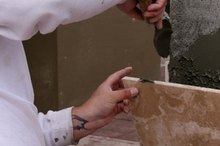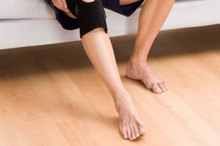How to Treat Bursitis in the Arm
Bursitis is a chronic condition that involves an inflammation of the bursa sacs in the body. These fluid filled sacs are found where tendons connect to bones and they help to reduce friction as you move. In your arm you can get bursitis in the shoulder, elbow or wrist. No matter where bursitis is located in the body, there are steps you can take to treat and manage your condition.
Techniques to Treat Arm Bursitis
Rest and Brace the area. The first step in treating your bursitis, is to rest the area until the inflammation subsides. Bursitis is often caused by overuse or repetitive use of the joint that is affected. Learning to use correct body mechanics and reducing stress on the joint will help to keep your symptoms in check. Using a brace can also help by keeping the area still as you move. Talk to your physician about working with a physical or occupational therapist to learn proper body mechanics, work habits and bracing techniques.
Tile Layers and Knee Problems
Learn More
Apply ice. Using ice is always helpful when you have bursitis or any kind of inflammation. Using ice on the area will help to constrict the blood vessels. This will reduce swelling and numb the area, allowing it to heal. Elevating the area above the level of the heart while applying ice will also help. You may need to do this during the acute phase of the bursitis and whenever you participate in activities that stress the affected joint.
Talk to your doctor about cortisone injections. You may need one injection or a series depending on the severity of your conditions. An injection delivers anti inflammatory medication directly to the bursae to help reduce the pain and swelling. Cortisone injections do not always work, and there are risks associated with injections so make sure you weight this option carefully.
What is a Valgus Knee Brace?
Learn More
Take anti inflammatory medications. Your doctor may prescribe anti inflammatory and pain medication to help manage your symptoms. You may need to take these medications regularly for a few weeks to get your symptoms under control. Your doctor may then recommend you cut back and only take the medication after strenuous activity or when your symptoms are worse. Some cases of bursitis are the result of an infection. In this case you may also need to take antibiotics. Your physician may also recommend draining fluid from the bursae when less invasive techniques are not successful.
Get moving. Whenever there is an injury involving a joint it will be necessary to do the appropriate exercises. Stretching and strengthening the muscles around the affected joint will help to take pressure off of the joint and it will reduce your pain. When your muscles become tight and deconditoned, they pull on the joint as you move, which will exacerbate your symptoms. Working with a physical therapist can help you to learn the right kind of exercises to do based on your individual situation and needs.
Consider surgery for severe cases. In rare cases where the damage to the bursae is severe or your symptoms are affecting you ability to work and remain independent, surgical removal of the bursae may be necessary. A bursectomy can be done using minimally invasive surgery techniques and usually has good results.
Tips
Learning to use good body mechanics and proper techniques in work and sporting activities is an important step in preventing and managing bursitis.
Warnings
Never ignore pain, it is your body's way of telling you that something is wrong. The longer you go without treatment the longer it will take to recover.
Related Articles
Resources
Writer Bio
I hold a Master's degree in exercise physiology/health promotion. I am a certified fitness specialist through the American College of Spots Medicine and an IYT certified yoga teacher. I have over 25 years experience teaching classes to both general public and those with chronic illness. The above allows me to write directly to the reader based on personal experiences.







